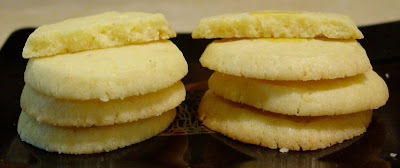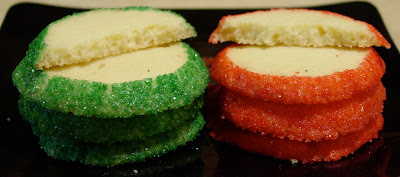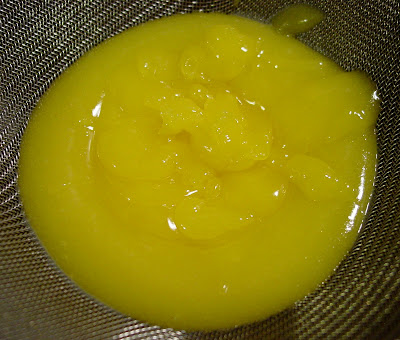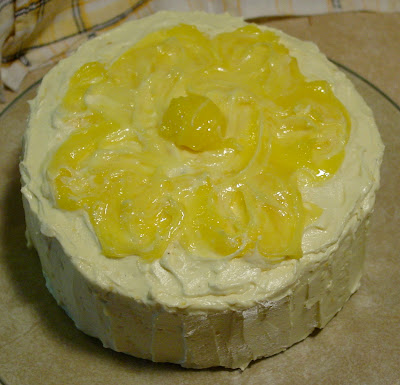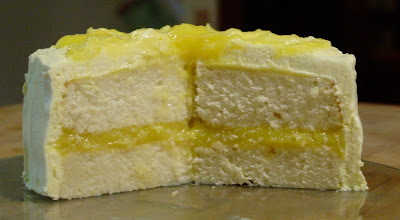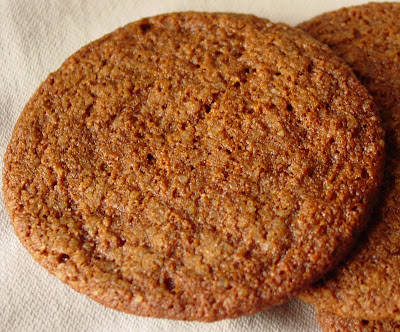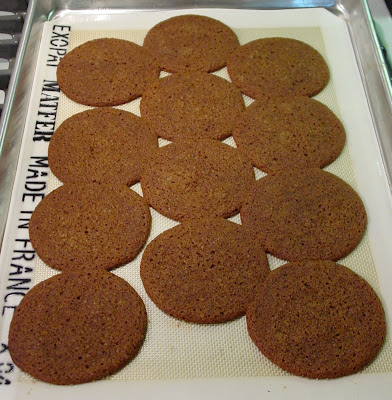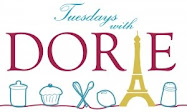This week's recipe for
Tuesdays with Dorie is for the French shortbread-style cookies known as Sablés, chosen by -- me! (For the recipe, scroll down to the bottom of this post.)

When I joined TWD in June of 2008, I wasn't really concerned about when I would get to choose a recipe. I figured I'd just try these blogging and bake-along activities for a while and see if I liked them. And the rest is history...
Thank you to our founder
Laurie and all the TWD bakers for such a great time! I hope you enjoyed these cookies and look forward to seeing all your variations. I made three batches -- plain sablés rolled in colored sugar, lemon sablés, and lime sablés shaped as rectangles. (I used whole beaten egg rather than egg yolk to brush the outsides of the sugared ones. I have too many left-over egg whites already!)
Why do some of them have yellow or green dots on top, you may ask? Good question! Come back Tuesday evening for my
post on the results of the Sablé Scientific Experiments.
(Sorry, it took until Wednesday but the results are up now.)Meanwhile, here are three hints for shaping cookie dough logs. This first one is from one of Nick Malgieri's cookbooks -- put the dough on wax paper, wrap the paper around and leave a "tail" (see picture), and use something thin and firm to push/pull the roll into shape. (I used a thin plastic cutting mat.) Push your mat (or whatever) into the fold of the wax paper and gently pull the bottom layer of wax paper towards you. Don't be too vigorous or you'll tear the wax paper (parchment is stronger, but more expensive).

Tightening the roll
Second, here's a nice way to make sure your logs don't flatten out when you chill them -- cut open the cardboard tube from the center of a paper towel roll, and use it to hold the wrapped dough until it is firm.
And when you slice the rolls, rotate them a bit after every one or two cuts. It keeps them from flattening too much on one side.
Edited to add: thanks to the folks who noticed that these last two hints are also in Dorie's book, on page 137.
For the rectangular lime sablés, I used Dorie's trick from the Pecan Shortbreads on page 127, and put the dough into two small plastic bags to chill. I ended up with two rectangles, each about 6 inches by 6 1/2 inches. Then I used a ruler and a long knife to cut them into smaller rectangles.

Sablé shaping tools
How do they taste? Well, they've only been out of the oven an hour or so. They're good now, but I know from previous experience that Dorie is right -- they are much better the next day. It's so hard to wait...
Recipe
from "Baking: From My Home to Yours," pages 131-133
by Dorie Greenspan
(Note: weights added by Bungalow Barbara)
Sablés, rich, tender shortbread cookies, are as popular in France as chocolate chip cookies are in America. And for several good reasons: the pure flavor of butter, the cookie's key player; a paradoxical but paradisical texture -- the cookie is both crumbly and melt-in-your-mouth tender; and it has an anytime rightness that makes it as perfect with a tall glass of milk, a bowl of ice cream or a basket of berries as it is on a petits fours tray in France's grandest restaurants. I learned to make sablés in Paris working with some of the city's best pâtissiers, and this master recipe is based on what they taught me -- the Playing Around variations are my American riffs on their standard.
The dough for sablés is shaped into logs and then sprinkled with sugar before it is sliced and baked. During the year, I coat the logs with sparkly white decorating sugar. When the holidays come around, I double the recipe and go mad with color, sprinkling some of the logs with brilliant red sugar, some with green and some with a rainbow mix. Trimmed in color and packed in festive tins, these make terrific Christmas cookies.
If you're new to sablés, take a look at the pointers (below) before you set to work.
2 sticks (1 cup / 8 ounces / 227 grams) unsalted butter, at room temperature
1/2 cup sugar (3.5 oz. / 100 gm.)
1/4 cup confectioners' sugar, sifted (1.0 oz. / 28 gm.)
1/2 teaspoon salt, preferably fine sea salt
2 large egg yolks (7 teaspoons / 35 ml. / 1.3 oz. / 37 gm.), at room temperature, plus 1 large egg yolk, for brushing the logs
2 cups all-purpose flour (9.6 oz. / 272 gm.)
Decorating (coarse) sugar
Makes about 50 cookies
Working with a stand mixer, preferably fitted with a paddle attachment, or with a hand mixer in a large bowl, beat the butter at medium speed until smooth and very creamy. Add the sugars and salt and beat until well blended, about 1 minute. The mixture should be smooth and velvety, not fluffy and airy. Reduce the mixer speed to low and beat in 2 of the egg yolks, again beating until the mixture is homogeneous.
Turn off the mixer. Pour in the flour, drape a kitchen towel over the stand mixer to protect yourself and the counter from flying flour and pulse the mixer at low speed about 5 times, a second or two each time. Take a peek -- if there is still a lot of flour on the surface of the dough, pulse a couple more times; if not, remove the towel. Continuing at low speed, mix for about 30 seconds more, just until the flour disappears into the dough and the dough looks uniformly moist. (If most of the flour is incorporated but you've still got some in the bottom of the bowl, use a rubber spatula to work the rest of the flour into the dough.) The dough will not clean the sides of the bowl, nor will it come together in a ball -- and it shouldn't. You want to work the dough as little as possible. What you're aiming for is a soft, moist, clumpy (rather than smooth) dough. Pinch it, and it will feel a little like Play-Doh.

This is how you want your dough to look. (This is a half-batch.)
Scrape the dough out onto a smooth work surface, gather it into a ball and divide it in half. Shape each piece into a smooth log about 9 inches long: it's easiest to work on a piece of plastic wrap and use the plastic to help form the log. Wrap the logs well and refrigerate them for at least 3 hours, preferably longer. (The dough can be kept in the refrigerator for up to 3 days or frozen for up to 2 months.)
GETTING READY TO BAKE: Center a rack in the oven and preheat the oven to 350 degrees F. Line two baking sheets with parchment or silicone mats.
Remove a log of dough from the refrigerator, unwrap it and place it on a piece of parchment or wax paper. Whisk the remaining egg yolk until it is smooth, and brush some of the yolk all over the sides of the dough -- this is the glue -- then sprinkle the entire surface of the log with decorating sugar.
Trim the ends of the roll if they're ragged, and slice the log into 1/3-inch-thick cookies. (You can make these as thick as 1/2 inch or as thin as -- but no thinner than -- 1/4 inch.) Place the rounds on the baking sheets, leaving an inch of space between them.
Bake one sheet at a time for 17 to 20 minutes, rotating the baking sheet at the midway point. When properly baked, the cookies will be light brown on the bottom, lightly golden around the edges and pale on top; they may feel tender when you touch the top gently, and that's fine. Remove from the oven and let the cookies rest a minute or two before carefully lifting them onto a rack with a wide metal spatula to cool to room temperature.
(Note from Barbara: mine only took about 14-15 minutes to bake. I did slice them fairly thin.)
Repeat with the remaining log of dough, making sure the baking sheets are cool before you bake the second batch.
SERVING: Serve these with anything from lemonade to espresso.
STORING: The cookies will keep in a tin at room temperature for about 5 days. If you do not sprinkle the sablés with sugar, they can be wrapped airtight and frozen for up to 2 months. Because the sugar will melt in the freezer, the decorated cookies are not suitable for freezing.
Playing Around
LEMON SABLÉS: Working in a small bowl, using your fingers, rub the grated zest of 1 to 1 1/2 lemons (depending on your taste) into the granulated sugar until the sugar is moist and very aromatic, then add this and the confectioners' sugar to the beaten butter. (Sablés can also be made with orange or lime zest; vary the amount of zest as you please.)
PECAN SABLÉS: Reduce the amount of flour to 1 1/2 cups, and add 1/2 cup very finely ground pecans to the mixture after you have added the sugars. (In place of pecans, you can use ground almonds, hazelnuts or walnuts.) If you'd like, instead of sprinkling the dough logs with sugar, sprinkle them with very finely chopped pecans or a mixture of pecans and sugar.
SPICE SABLÉS: Whisk 1 1/2 teaspoons ground cinnamon, 1/2 teaspoon ground ginger and 1/4 teaspoon freshly grated nutmeg into the flour.
PARMESAN SABLÉS: For savory sablés that are ideal with aperitifs, omit both the granulated and confectioners' sugar and add 3/4 cup (2 1/4 ounces) very finely grated Parmesan to the beaten butter. These are fine plain, but the logs can also be brushed with beaten egg yolk and sprinkled with finely chopped almonds. If you love salt, press a few grains of fleur de sel gently into the top of each sablé before slipping the baking sheet into the oven.
Tips for Shortbreads and Sablés, from p. 124 of "Baking: From My Home to Yours"
What you call the fabulously buttery, slightly gritty, tender, sandy-textured cookies that are so right with tea or coffee may depend on where you live. In France, the cookies are known as sablés, galettes or palets; in Scotland, they're shortbread; and here, at home, they are shortbread, sand tarts or simply butter cookies.
At their most elemental and traditional, shortbreads and their kin are made of butter, sugar -- either granulated or confectioners', or a combination of the two -- and flour. And, although some recipes have an egg or two, or maybe just yolks, it's not the eggs that define the cookies, it's the other ingredients and, most important, how you handle them.
Here's all you need to know to get perfectly crumbly shortbread or sablés every time.
Use fresh butter that is soft, but not at all greasy -- if your butter is sitting in an oily puddle, it's gone too soft and your sablés won't have their characteristic sandiness.
Don't beat the butter (or the butter, sugar and eggs) so enthusiastically that the mixture is light and fluffy. You don't want to beat air into this dough, because it would cause the cookies to puff as they bake in the oven and sink as they cool on the counter.
Be soft and gentle when you blend in the flour. This is the make-or-break step in the process. With the word "sandy" singing in your head, add the flour all at once and mix it only until it disappears into the dough. To guard against overmixing, you can mix in the last of the flour by hand.
Shape the dough as the recipe directs and then make sure to give it a good, long chill; it will improve the flavor of the cookies and help them keep their shape under the oven's heat. Try to refrigerate the dough for at least 2 hours, but know that longer is better.
Cool the cookies completely before you serve them. As seductive as the smell of warm butter, sugar and flour is, the cookies taste better when they reach room temperature.
You can also find the recipe at this link on the NPR web site (scroll down a bit). And for tips on cookie-baking in general, see this link. Edited to add: thanks for the folks who spotted the recipe at this link as well -- and see the article, too!



